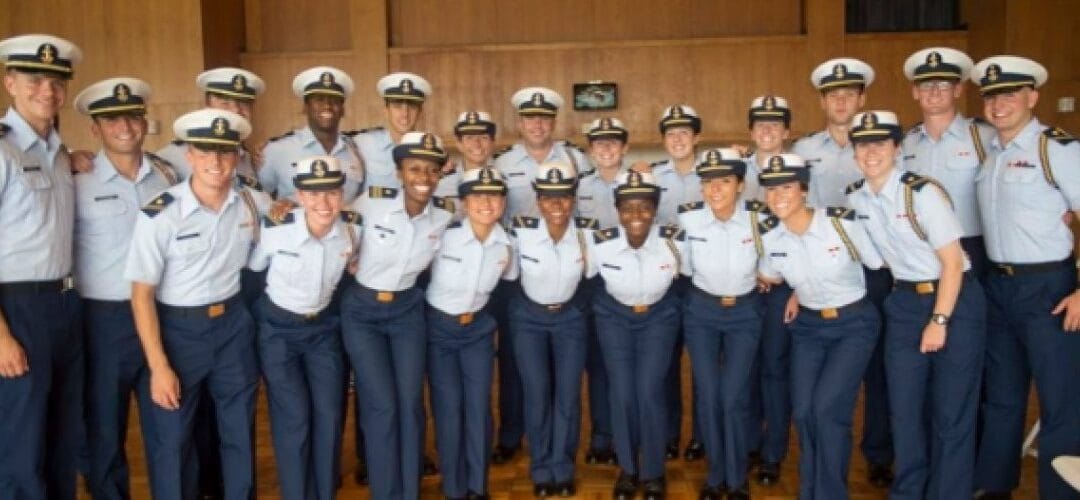By Paul Culp, MA (Oxon.), CFT, GCDF, CCSP
A little over two months ago, we interviewed a recent graduate of the U.S. Merchant Marine Academy (July 10, The Ensign’s Tale), and although we are unable to give equal time to the other service academies, we thought it would be useful to provide some basic information on each institution and perhaps make a few comparisons.
While the service academies have a great deal in common with one another—substantial and in most cases total financial aid, academic rigor, relentless leadership training, a strong emphasis on STEM subjects, and a considerable post-graduation service obligation-—they differ from each other in size, demographics, and physical environment. Here are the basics:
The U.S. Military Academy

The U.S. Military Academy at West Point, New York, often referred to as West Point or USMA (or simply as Army in the context of intercollegiate athletics) is the oldest of the service academies, having been established in 1802 during the administration of President Thomas Jefferson. Its picturesque campus, with predominantly granite architecture in the Norman style, is a popular tourist attraction.
Applicants must be in the 17-to-23 age range as of July 1 of their enrollment year, unmarried, and with no dependent children. Admission requires nomination by the applicant’s Congressman or U.S. Senator (or by the President or Vice President of the United States, for those who are exceptionally well-connected), and about 13 percent of applicants are admitted out of roughly 15,000 each year. Of those accepted, about 85 percent choose to attend. Total enrollment is around 4,300, and the graduation rate is approximately 77 percent. About 16 percent of cadets are female, according to My College Guide, and 27 percent are minorities.
In exchange for post-graduate service in the Army, cadets receive what is essentially a free ride, plus a monthly stipend. West Point offers 45 majors leading to bachelor of science degrees. The curriculum calls for small classes, daily homework, and frequent testing.
Most graduates are commissioned as second lieutenants in the Army, though a few each year exercise their option of being commissioned in one of the other branches of the service. The service obligation entails five years of active duty and three years in the reserves. Cadets who fail to graduate after beginning their third year at West Point must fulfill their service obligation as enlisted personnel.
Army athletic teams—15 for men and nine for women—compete at the top level of NCAA Division I. Each cadet must participate in an intercollegiate, club, or intramural sport each semester.
The U.S. Naval Academy

The U.S. Naval Academy at Annapolis, Maryland, often called simply Annapolis or USNA or Navy, was established in 1845. Its admissions requirements are similar to those of West Point, but selection is even more competitive: Only about 7 to 9 percent of applicants are accepted, out of about 20,000, with roughly 87 percent of those accepted choosing to make the commitment. Total enrollment is approximately 4,500, with an 80-plus-percent graduation rate. Nearly a third of midshipmen are female, and slightly more than a third are minorities. Financial arrangements are essentially the same as those of West Point.
Annapolis offers 22 majors, and most graduates are commissioned as ensigns in the Navy or second lieutenants in the Marine Corps, while a few are commissioned in other branches or in the forces of allied nations. The minimum service obligation is five years, but aviators must serve from six to eleven years, depending on the nature of their training and duties. Midshipmen who fail to graduate after beginning their third year must, like West Point cadets, serve on active duty as enlisted personnel–except for cases in which the Secretary of the Navy commutes the obligation to a six-figure reimbursement of their academy expenses.
Like its arch-rival Army, Navy competes in NCAA Division I. The academy offers 30 intercollegiate sports and requires midshipmen to compete in varsity, club, or intramural sports, with a few exceptions for support activities such as drum-and-bugle corps.
The U.S. Air Force Academy

The Air Force is the youngest of the services—it was part of the Army until 1947—and the USAFA in Colorado Springs is the newest of the academies, having been established in 1954. Its architecture is redolent of the Jet Age and Space Age, and its parade uniforms were designed by Hollywood filmmaker Cecil B. DeMille (The Ten Commandments, The Greatest Show on Earth, Cleopatra).
Applications run in the 10,000-to-12,000 range annually, with about 12 percent being accepted and 85 percent of the successful applicants enrolling. Total enrollment is a little over 4,000, with a graduation rate of about 80 percent. Women comprise roughly 15 percent of cadets, minorities approximately 25 percent. Financial arrangements are similar to those at West Point and Annapolis.
The USAFA offers 27 majors, and slightly more than half of cadets choose non-technical majors, although all programs lead to a bachelor of science degree because of the highly technical nature of the core curriculum.
Graduates are commissioned as second lieutenants in the Air Force. The minimum service obligation is five years of active duty and three of inactive reserve duty, but aviators can incur an obligation of up to 10 years. Cadets who fail to graduate after beginning their third year must complete their service obligation in the enlisted ranks.
USAFA athletic teams—17 for men and 10 for women—compete in NCAA Division I. As with West Point and Annapolis, athletic participation is required.
The U.S. Coast Guard Academy

The U.S. Coast Guard Academy (USCGA), established in 1932 at New London, Connecticut, differs from the other service academies in not requiring a Congressional (or Vice Presidential or Presidential) appointment and in not having any type of geographic quota. The at-large selection process results in about 2,000 applications per year, of which approximately 17 percent are accepted. Of those, 85 percent choose to attend. Total enrollment is just under 1,000, with a graduation rate of about 80 percent. A third of cadets are female, and slightly more than a quarter are minorities.
The academy offers nine academic majors, including government and management, but the core curriculum is heavily weighted toward technical subjects. An open-enrollment agreement with nearby Connecticut College allows cadets to take courses there as needed. Financial arrangements are similar to those of the other military academies.
Graduates are commissioned as ensigns in the Coast Guard. The service obligation is a minimum of five years, longer for those who pursue flight training or graduate school. The obligation for those who fail to complete the course is similar to that imposed by the other services.
Athletics are at the NCAA Division III level, with 24 sports on offer and a requirement that cadets participate in varsity, club, or intramural sports.
The U.S. Merchant Marine Academy

The U.S. Merchant Marine Academy at Kings Point, New York (USMMA or simply Kings Point) opened in 1943 and receives approximately 2,000 applications per year, accepting 15 to 20 percent. About 70 percent of those accepted choose to enroll. Total enrollment is around 1,000, with a graduation rate of 81 percent. USMMA was the first of the academies to begin accepting female students—in 1974, two years before the others—and about 18 percent of midshipmen are women, with roughly 20 percent being minorities.
Financial arrangements at USMMA differ markedly from those of the other academies. The federal government covers tuition and fees, room and board, uniforms, and books, but an assortment of other supplies and services are the responsibility of the individual. (Though midshipmen do not receive the monthly stipend that the other academies provide, they are paid while training at sea, concerning which more in a moment.) Applicants for admission to Kings Point may obtain financial aid by conventional means, as they would for other colleges and universities.
USMMA has other highly distinctive features. Our sources tell us that life there is less structured than at the other academies, but that the academic load is brutal because midshipmen spend an entire year at sea—a departure from the summer training required at the other academies—and must make up for that long absence by taking more classes the rest of the time. Five academic majors are available, all of an explicitly maritime nature, and USMMA claims that it requires more hours for a degree than any of the other academies.
Kings Point graduates also do not owe a service obligation to any particular branch, but may serve in any of the branches, the National Oceanic and Atmospheric Administration, the U.S. Public Health Service, or in the maritime industry (the latter option entailing an eight-year military reserve obligation as well).
While West Point, Annapolis, and the Air Force Academy are all under the governance of the Defense Department and their students are considered active-duty members of the military, as are cadets at the Coast Guard Academy, which is under the aegis of the Department of Homeland Security, the Merchant Marine Academy is governed by the U.S. Maritime Administration, and midshipmen are not considered active-duty military personnel.
Like the Coast Guard, USMMA competes in NCAA Division III, offering a total of 28 varsity sports.
The service academies obviously are not for everyone. A large majority of successful applicants rank in the top 20 percent of their high school classes. Physical fitness standards are rigorous. Academy life is highly structured, to say the least, combining grueling academic pressure with the demands of military life. The service obligation on top of the four-year course means an overall commitment of nearly a decade at a minimum, and perhaps more.
On the other hand, the academies are among the most highly ranked academic institutions in the country. Graduation provides an unusual degree of job security. The opportunity for a long-term military or maritime career is obvious. All of the academies offer leadership training that can prove valuable in almost any career. For high school students who hold themselves to a high standard and who want to do something extraordinary, especially in the realm of service to their country, the challenge of academy life can be a powerful attraction.
Last but not least, an academy education is worth nearly half a million dollars.
The Coaching Educator has ample experience helping high school students and their families determine whether an academy appointment is appropriate, and assisting in the pursuit of that goal. The selection process for the service academies is highly competitive and quite complex, and it’s important to begin preparing yourself and weighing your options as early in high school as possible.
To learn more about our philosophy and capabilities, be sure to watch our free webinars, listen to our podcasts, sign up for our four-week College App Boot Camp, consider our Ultimate Programs and our special services for athletes and performing-arts students, and book a consultation to hear what we can do for you and how we do it. Keep reading this blog, and look for us on social media (see links below) as we keep our clients and admirers advised of new developments in our effort to help students get into and succeed at the right school.
Recommended Reading About College Admissions and Scholarships
Culp, Paul. “The Ensign’s Tale: We Talk to a Recent Academy Graduate,” The Coaching Educator, 10 July 2018, http://tce.local/2018/07/10/the-ensigns-tale-we-talk-to-a-recent-academy-graduate/
Culp, Paul. “The Basics of Applying for the Service Academies,” The Coaching Educator, 13 February 2019, http://tce.local/2019/02/13/the-basics-of-applying-for-the-service-academies/
Culp, Paul. “ROTC Scholarships: Uncle Sam Wants You, and He Has Deep Pockets,” The Coaching Educator, 30 August 2018, http://tce.local/2018/08/30/rotc-scholarships-uncle-sam-wants-you-and-he-has-deep-pockets/
Support smart students and spread the word:
https://www.facebook.com/thecoachingeducator
https://www.youtube.com/user/KeirinCarroll
https://twitter.com/TCEducator
https://www.instagram.com/thecoachingeducator
https://www.linkedin.com/company/thecoachingeducator
Follow us on:
YouTube: https://tinyurl.com/yy5yssq8

